
Rudbeckia hirta, commonly called black-eyed Susan, is a North American flowering plant in the family Asteraceae, native to Eastern and Central North America and naturalized in the Western part of the continent as well as in China. It has now been found in all 10 Canadian Provinces and all 48 of the states in the contiguous United States.

Rudbeckia is a plant genus in the Asteraceae or composite family. Rudbeckia flowers feature a prominent, raised central disc in black, brown shades of green, and in-between tones, giving rise to their familiar common names of coneflowers and black-eyed-susans. All are native to North America, and many species are cultivated in gardens for their showy yellow or gold flower heads that bloom in mid to late summer.

Rudbeckia laciniata, the cutleaf coneflower, is a species of flowering plant in the family Asteraceae. It is native to North America, where it is widespread in both Canada and the United States. Its natural habitat is wet sites in flood plains, along stream banks, and in moist forests. Common names other than cutleaf coneflower include cutleaf, goldenglow, green-headed coneflower, tall coneflower, sochan and thimbleweed.

Rudbeckia fulgida, the orange coneflower or perennial coneflower, is a species of flowering plant in the family Asteraceae, native to eastern North America.
Rudbeckia alpicola, the showy coneflower, Washington coneflower, or Wenatchee mountain coneflower. It is a perennial flowering plant native to Washington state in the United States.
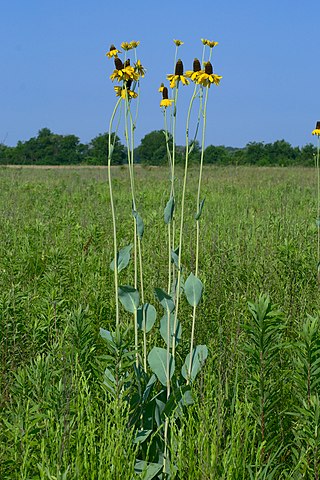
Rudbeckia maxima, the great coneflower, is a flowering plant in the family Asteraceae, which is used as an ornamental plant. They can reach a maximum height of eight feet. Once it produces seeds, finches and other small birds come to feed on them.

Escobaria missouriensis, the Missouri foxtail cactus and formerly Coryphantha missouriensis, is a species of low-growing North American cacti. It is found in along the Missouri River in the tallgrass prairie and shortgrass Great Plains, from Texas to Montana and the Dakotas, and in the Rocky Mountains woodlands of Ponderosa pine, pinyon-juniper, and Gambel oak west of it. It is also native to the Southwestern United States in Arizona, New Mexico, and Utah.

Rudbeckia triloba, the browneyed or brown-eyed susan, thin-leaved coneflower or three-leaved coneflower, is a species of flowering plant in the family Asteraceae with numerous, yellow, daisy-like flowers. It is native to the central and eastern United States and is often seen in old fields or along roadsides. It is also cultivated as an ornamental.

Pellaea glabella is a fern with the common name smooth cliffbrake. It was once regarded as a reduced form or variety of Pellaea atropurpurea. P. glabella is known to exist in two cryptic species, one diploid and one tetraploid. The diploid reproduces sexually, while the tetraploid is normally apogamous. It is now known that the tetraploid form of the species is one of the parents of the original hybrid P. × atropurpurea that became the apogamous species.

Rudbeckia occidentalis is a species of flowering plant in the family Asteraceae known by the common name western coneflower. It is native to the northwestern United States from Washington to northern California and east to Wyoming and Montana, where it grows in moist habitat types, such as meadows. It is an erect perennial herb growing from a thick rhizome, its mostly unbranched stem approaching two meters in maximum height. The large leaves are generally oval but pointed, and lightly to deeply toothed along the edges, growing to 30 centimeters long. The inflorescence is one or more flower heads with purplish bases up to 6 centimeters wide. There are no ray florets, just an array of reflexed phyllaries around the purple-brown center packed with disc florets. This center, containing the receptacles, lengthens to several centimeters in length as the fruits develop. The fruits are achenes each a few millimeters long, some tipped with pappi of tiny scales.

Oenothera macrocarpa, the bigfruit evening primrose, Ozark sundrops, Missouri evening primrose, or Missouri primrose, is a species of flowering plant in the evening primrose family Onagraceae, native to northeast Mexico and the south-central United States, where it is found in calcareous prairies and limestone outcrops.
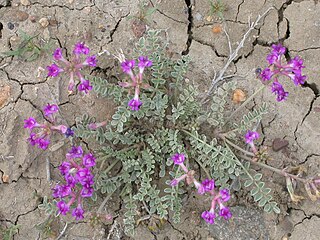
Astragalus missouriensis is a species of flowering plant in the legume family known by the common name Missouri milkvetch. It is native to central North America, where it is common and widespread.

Solidago missouriensis is a species of flowering plant in the family Asteraceae known by the common names Missouri goldenrod and prairie goldenrod. It is native to North America, where it is widespread across much of Canada, the United States, and northern Mexico. It grows from British Columbia east to Manitoba, south as far as Sonora, Coahuila, Texas, and Mississippi.
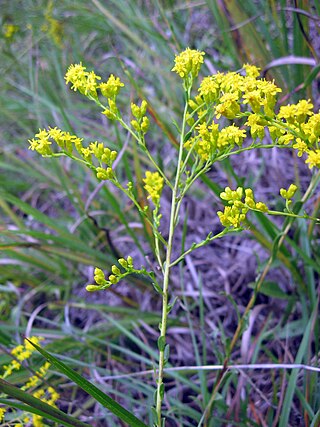
Solidago gattingeri, common name Gattinger's goldenrod, is a species of plant that is a goldenrod. It is native only to the Ozark Mountains of Arkansas and Missouri and to the Nashville Basin of Tennessee. Its preferred habitat is cedar glades, cedar barrens, and limestone outcrops. It is adapted to dry habitats.
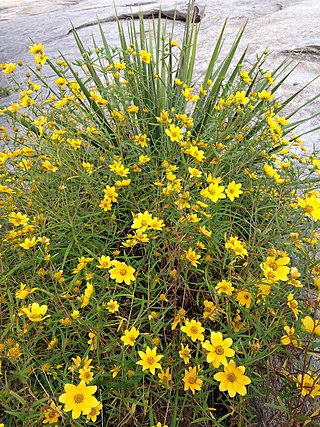
Helianthus porteri is a species of sunflower known by the common names Porter's sunflower, Stone Mountain daisy and Confederate daisy. The term "daisy" is imprecise because the species is a sunflower (Helianthus) rather than a daisy. Likewise, although the plant grows on Stone Mountain, GA, its range extends well beyond. The connection to the Confederacy is through Stone Mountain which contains a confederate monument, although the connection is tenuous as the species was named before the Civil War in 1849 by Harvard botanist Asa Gray in honor of Thomas Conrad Porter, a Pennsylvanian minister and botanist who collected the plant in Georgia. Gray initially named the plant Rudbeckia porteri, later changed to Helianthus in 1998 by John F. Pruski.
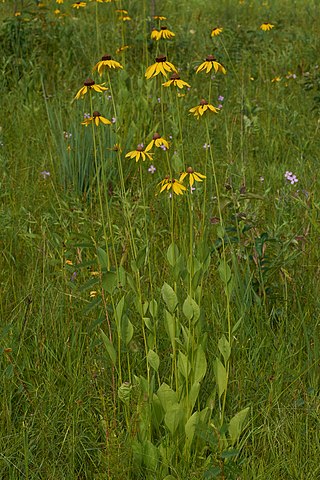
Rudbeckia grandiflora, commonly called rough coneflower, is a species of flowering plant in the family Asteraceae.

Rudbeckia subtomentosa, the sweet coneflower, is a flowering plant in the family Asteraceae and is found in the central United States.
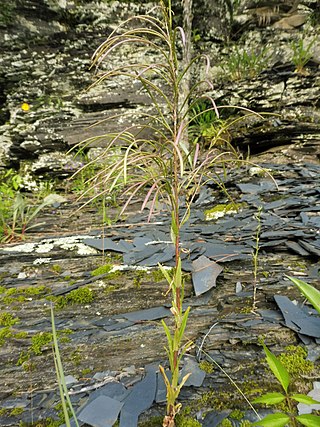
Boechera missouriensis, commonly called Missouri rockcress, is a species of flowering plant in the mustard family (Brassicaceae). It is native to the eastern United States, where it has a highly fragmented range localized in the Northeast, the Upper Midwest, the Interior Highlands, and the Southeast. Its natural habitat is typically on rocky or sandy woodlands and bluffs, in areas of acidic soil. It is generally uncommon throughout most of its range, with exception for the Interior Highlands region.
Rudbeckia graminifolia, the grassleaf coneflower, is a species of flowering plant. It grows in parts of the Florida Panhandle. It produces tubular disc flowers, which go on to form seeds and ray flowers. The flowering plants have been spotted in wet roadside ditches.

















